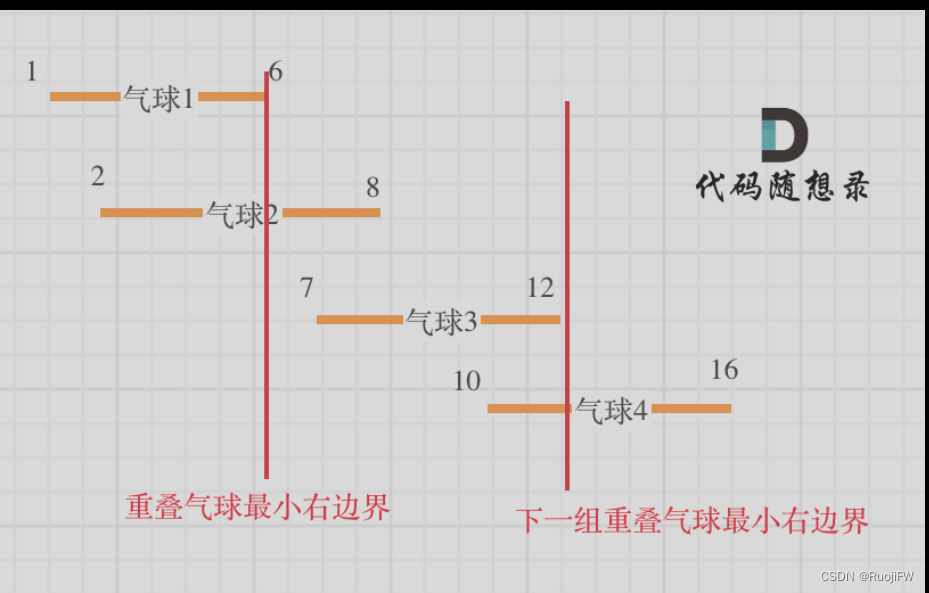代码随想录算法训练营第三十五天| 860.柠檬水找零 406.根据身高重建队列 452. 用最少数量的箭引爆气球
创始人
2025-05-30 02:08:17
860.柠檬水找零
题目链接
思路:
情况一:账单是5,直接收下。
情况二:账单是10,消耗一个5,增加一个10
情况三:账单是20,优先消耗一个10和一个5,如果不够,再消耗三个5
class Solution {
public:bool lemonadeChange(vector& bills) {int five = 0, ten = 0, twenty = 0;for (auto bill : bills) {if (bill == 5) {five++;}if (bill == 10) {if (five == 0) return false;else {five--;ten++;}}if (bill == 20) {// 有10 没 5if (ten >= 1 && five >= 1) {ten--;five--;}//没10 5 >3else if (ten == 0 && five >= 3) {five -= 3;}else {return false;}}}return true;}
};
总结:难度不大,需要静下心来完成,思考每种情况,就很容易解决这道题。
406.根据身高重建队列
题目链接
**思路:**和分发糖果那道题类似,先进行一个维度上的排列,再对另一个维度进行排序。
首先对身高进行排序,从大到小排序,然后再对前面有几个进行选择插入。这里就要实现一个比较的方法,实现这个效果。
class Solution {
public:static bool cmp(vector &a, vector &b) {if (a[0] == b[0]) return a[1] < b[1];return a[0] > b[0];}vector> reconstructQueue(vector>& people) {sort(people.begin(), people.end(), cmp);vector> que;for (int i = 0; i < people.size(); i++) {int pos = people[i][1];que.insert(que.begin() + pos, people[i]);}return que;}
};
明显看是使用C++中的list(底层链表实现)比vector(数组)效率高得多。对使用某一种语言容器的使用,特性的选择都会不同程度上影响效率。
// 版本二
class Solution {
public:// 身高从大到小排(身高相同k小的站前面)static bool cmp(const vector& a, const vector& b) {if (a[0] == b[0]) return a[1] < b[1];return a[0] > b[0];}vector> reconstructQueue(vector>& people) {sort (people.begin(), people.end(), cmp);list> que; // list底层是链表实现,插入效率比vector高的多for (int i = 0; i < people.size(); i++) {int position = people[i][1]; // 插入到下标为position的位置std::list>::iterator it = que.begin();while (position--) { // 寻找在插入位置it++;}que.insert(it, people[i]);}return vector>(que.begin(), que.end());}
};
452. 用最少数量的箭引爆气球
题目链接
思路: 题目读起来很难受,但是实际做起来还是挺简单的。
首先对气球的左边界进行从小到大的排序,然后如下图所示。接着遍历数组,对当前气球的右边界和上一个气球的左边界进行比较,如果一家超过了,那么一定需要一根箭,当重叠的时候,降新的用于判断的边界换成重叠时候最小的边界,继续下一轮判断。

class Solution {
private:static bool cmp(const vector& a, const vector& b) {return a[0] < b[0];}
public:int findMinArrowShots(vector>& points) {if (points.size() == 0) return 0;sort(points.begin(), points.end(), cmp);int result = 1; // points 不为空至少需要一支箭for (int i = 1; i < points.size(); i++) {if (points[i][0] > points[i - 1][1]) { // 气球i和气球i-1不挨着,注意这里不是>=result++; // 需要一支箭}else { // 气球i和气球i-1挨着points[i][1] = min(points[i - 1][1], points[i][1]); // 更新重叠气球最小右边界}}return result;}
};
**总结:**理解起来很容易,但是自己想的时候感觉不容易想,不过边界排序这部分很熟悉了。
相关内容
热门资讯
世界上最漂亮的人 世界上最漂亮...
此前在某网上,选出了全球265万颜值姣好的女性。从这些数量庞大的女性群体中,人们投票选出了心目中最美...
北京的名胜古迹 北京最著名的景...
北京从元代开始,逐渐走上帝国首都的道路,先是成为大辽朝五大首都之一的南京城,随着金灭辽,金代从海陵王...
苗族的传统节日 贵州苗族节日有...
【岜沙苗族芦笙节】岜沙,苗语叫“分送”,距从江县城7.5公里,是世界上最崇拜树木并以树为神的枪手部落...
长白山自助游攻略 吉林长白山游...
昨天介绍了西坡的景点详细请看链接:一个人的旅行,据说能看到长白山天池全凭运气,您的运气如何?今日介绍...
